Ubiquiti PBE5AC PowerBeam 5AC User Manual PowerBeam PBE 5AC620 Quick Start Guide
Ubiquiti Networks, Inc. PowerBeam 5AC PowerBeam PBE 5AC620 Quick Start Guide
Ubiquiti >
Contents
- 1. Manual 300
- 2. Manual 400
- 3. Manual 500
- 4. Manual 620 pt1
- 5. Manual Omni
- 6. Manual 620 pt2
- 7. Manual 620 pt3
- 8. Manual 620 pt4
- 9. UNII-2 300
- 10. UNII-2 400
- 11. UNII-2 500
- 12. UNII-2 620 part 1 of 4
- 13. UNII-2 620 part 2 of 4
- 14. UNII-2 620 part 3 of 4
- 15. UNII-2 620 part 4 of 4
- 16. UNII-2 Omni
- 17. PBE-5AC300 User Manual
- 18. PBE-5AC400 User Manual
- 19. PBE-5AC500 User Manual
- 20. PBE-5AC-Omni
- 21. PBE-5AC620 User Manual Part 1 of 2
- 22. PBE-5AC620 User Manual Part 2 of 2
PBE-5AC620 User Manual Part 1 of 2
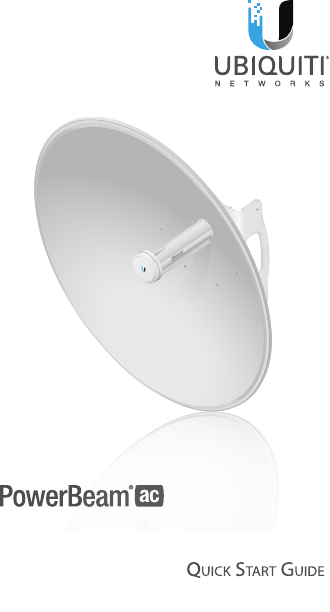
High-Performance
Integrated InnerFeed®
airMAX® ac Bridge
Model: PBE-5AC620
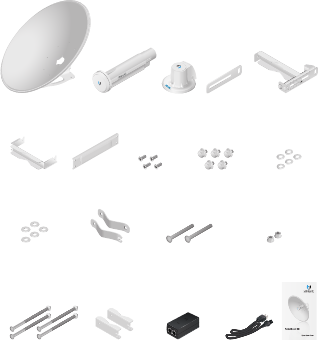
Introduction
Thank you for purchasing the Ubiquiti Networks®
PowerBeam®ac. This Quick Start Guide is designed to guide
you through installation and also includes warranty terms.
Package Contents
Dish Reflector with
Mounting Bracket
Antenna
Feed
Rear
Housing
Support
Arm
Upper Pole
Bracket Assembly
Lower Pole
Bracket
Brace Screws
(M6, Qty. 4)
Hex Head Bolts
(M8, Qty. 5)
Lock Washers
(M8, Qty. 5)
Flat Washers
(M8, Qty. 5)
Stabilizer Brackets
(Qty. 2)
M10x100 Bolts
(Qty. 2)
Serrated Flange Nuts
(M10, Qty. 2)
High-Performance
Integrated InnerFeed™
airMAX® ac Bridge
Model: PBE-5AC620
M8x150 Carriage
Bolts (Qty. 4)
Pole Clamps
(Qty. 2)
Gigabit PoE
Adapter with
Wall‑Mount Bracket
Power
Cord
Quick Start
Guide
TERMS OF USE: Ubiquiti radio devices must be professionally installed. Shielded Ethernet
cable and earth grounding must be used as conditions of product warranty. TOUGHCable™
is designed for outdoor installations. It is the customer’s responsibility to follow local country
regulations, including operation within legal frequency channels, output power, and Dynamic
Frequency Selection (DFS) requirements.
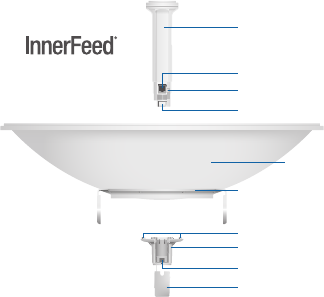
Hardware Overview
Bottom View
Cable Door
Rear Housing
Technology
Ethernet Port
Release
Button Slot
Release Button
Dish
Reflector
Alignment Pins
Reset Button
Antenna Feed
Mounting Bracket
Reset Button To reset to factory defaults, press and hold the
Reset button for more than 10 seconds while the PowerBeam
is already poweredon. Alternatively, the PowerBeam may be
reset remotely via a Reset button located on the bottom of the
Gigabit PoE Adapter.
Release Button After you assemble the PowerBeam, check
the Release button; it should be fully engaged in the Release
Button Slot of the Rear Housing. This ensures that the Antenna
Feed is locked into place. If you need to remove the Antenna
Feed, you must depress the Release button first.
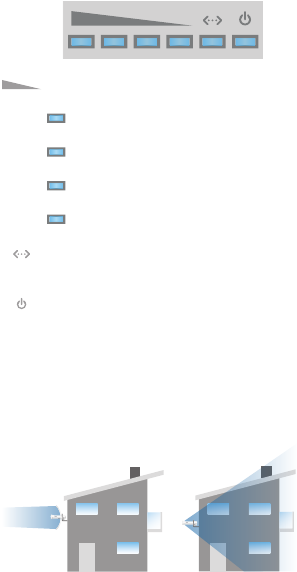
LEDs
Signal The default values (from left to right) are
shown below:
LED will light blue when the wireless signal
strength is equal to or above -65 dBm.
LED will light blue when the wireless signal
strength is equal to or above -73 dBm.
LED will light blue when the wireless signal
strength is equal to or above -80 dBm.
LED will light blue when the wireless signal
strength is equal to or above -94 dBm.
Ethernet The Ethernet LED will light steady blue
when an active Ethernet connection is made and
flash when there is activity.
Power The Power LED will light blue when the
device is connected to a power source.
Application Examples
The PowerBeam mounted
outdoors with the Dish
Reflector installed provides
directional outdoor coverage.
(The gain depends on the
reflector.)
The PowerBeam mounted
outdoors without the Dish
Reflector installed provides
outdoor‑to‑indoor coverage
using the 3 dBi Antenna
Feedonly.
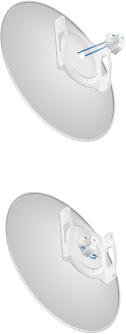
Installation Requirements
• Phillips screwdriver
• 13 mm wrench
• 16 mm wrench
• Shielded Category 5 (or above) cabling should be used for
all wired Ethernet connections and should be grounded
through the AC ground of the PoE.
We recommend that you protect your networks from the
most brutal environments and devastating ESD attacks
with industrial‑grade shielded Ethernet cable from Ubiquiti
Networks. For more details, visit www.ubnt.com/toughcable
Installation
1. Line up the Alignment Pins of the Rear Housing with the
alignment holes of the Dish Reflector. Insert the pins and
push until they lock intoplace.
2. Push in the sides of the Cable Door and detach it from the
Rear Housing.
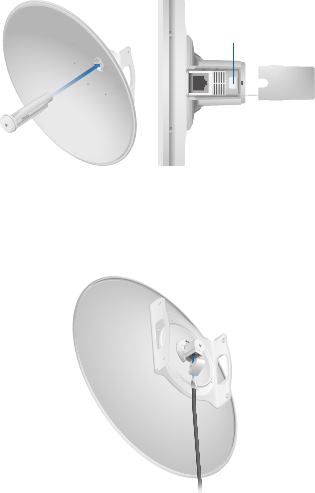
3. Attach the Antenna Feed:
a. Insert the Antenna Feed into the Rear Housing, and push
until it locks into place with a click.
b. Lightly pull the Antenna Feed to ensure that it is locked
into place and the Release button is fully engaged.
Release Button
Bottom View
4. Connect the Ethernet cable:
a. Connect an Ethernet cable to the Ethernet Port of the
Antenna Feed.
b. Re‑attach the Cable Door to the Rear Housing.
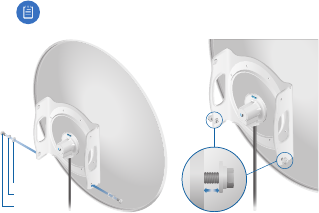
5. Attach two Hex Head Bolts, two Lock Washers, and two Flat
Washers to the bottom of the Mounting Bracket. Ensure that
there is a gap of 8 mm between each Flat Washer and the
Mounting Bracket.
Note: Ensure that each Lock Washer is always
installed between the Hex Head Bolt and Flat Washer.
Flat Washer
Lock Washer
Hex Head Bolt
8 mm
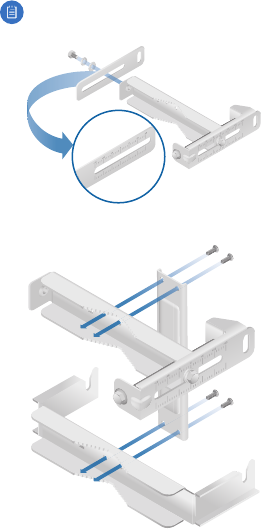
6. Attach the horizontal slot of the Support Arm to the Upper
Pole Bracket using a Hex Head Bolt, Lock Washer, and
FlatWasher.
Note: Ensure that the degree settings are the same
on both arms of the Upper Pole Bracket.
Degree markings
facing outward
7. Attach the Brace to the pole brackets using the four Screws.
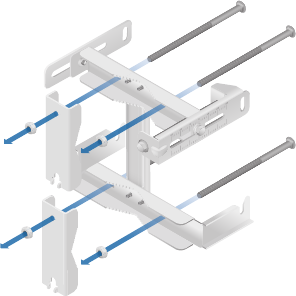
8. Each M8x150 Carriage Bolt includes a serrated flange nut.
Remove these and use them in the next step.
9. Attach one Pole Clamp to each pole bracket.
a. Insert two M8x150 Carriage Bolts into each pole bracket.
b. Slide the hole of a Pole Clamp over one bolt of each
pole bracket.
c. Place one serrated flange nut on each bolt.
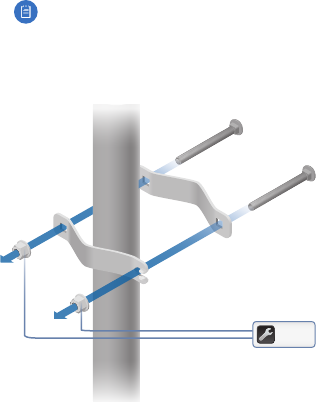
10. Attach the Stabilizer Brackets to the pole just beneath the
area where the PowerBeam will be attached.
Note: The pole‑bracket assembly can accommodate
a Ø 38 - 101mm pole.
a. Place one Stabilizer Bracket on each side of the pole.
b. Insert the two M10x100 Bolts into the Stabilizer Brackets.
c. Secure each bolt with one Serrated Flange Nut.
50 N-m
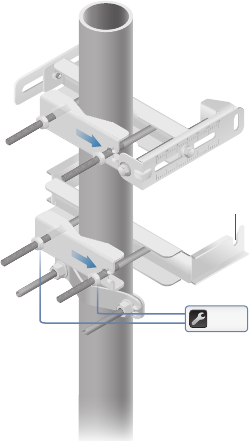
11. Attach the pole‑bracket assembly to the pole:
a. Slide the slot of each Pole Clamp over the
corresponding M8x150 CarriageBolt.
b. Tighten the serrated flange nuts of the bolts to secure
the pole-bracket assembly to the pole.
Proper slot orientation
25 N-m
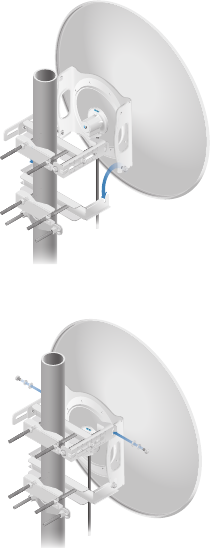
12. Lift the Dish Reflector and align the two lower Hex Head
Bolts with the slots on the Lower Pole Bracket. Seat the bolts
in the slots.
13. Attach each arm of the Upper Pole Bracket to the Mounting
Bracket using a Hex Head Bolt, Lock Washer, and Flat Washer.
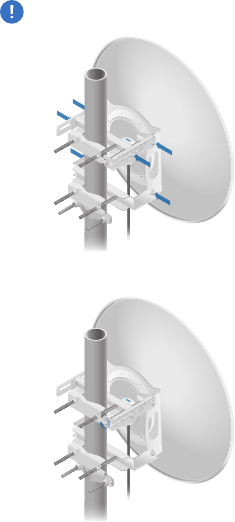
14. Before adjusting the tilt angle, ensure that the six Hex Head
Bolts are loose enough to allow movement.
IMPORTANT: If you cannot spin the washers freely by
hand, then loosen the Hex Head Bolts until you can.
15. To adjust the tilt angle, turn the screw head of the elevation
rod until the desired tilt is reached.
16. Lock the alignment by tightening all six FlangeBolts to
25 N-m.
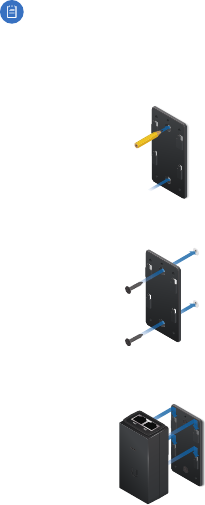
Note: Steps 17-20 are optional instructions for mounting
the Gigabit PoE Adapter on a wall.
17. Remove the wall‑mount bracket from the Gigabit PoE
Adapter and position it at the desired location on the wall
with the arrow pointing up.
18. Use a pencil to mark the two holes on the wall.
19. Attach the wall‑mount bracket to the wall using the
appropriate fasteners (not included).
20. Align the tabs of the Gigabit PoE Adapter with the slots
of the wall‑mount bracket and slide the Gigabit PoE
Adapterdown.
*640-00136-05*
640-00136-05